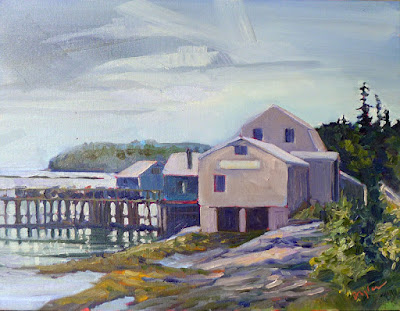Perhaps a little less plumage and a little more truth might build more cooperation in the workplace. You first.
| Parrsboro marshes, by Carol L. Douglas |
I wish I could get the timing right on Parrsboro International Plein Air Festival. Last year, I was a day late because I was teaching watercolor aboard American Eagle. This year I’m not quite so behind, but my husband has a medical procedure this morning. I’ll miss the opening reception where they stamp our boards.
I asked painter Stephan Giannini if he’d bring my boards up to Nova Scotia with him. He’ll hand them off to Poppy Balser, who’ll take them to the cottage we’re staying in. Neither Poppy nor Stephan hesitated when asked. “I’m going right by your house anyway,” said Stephan. I left my studio open so he could collect them while I was teaching elsewhere.
 |
| Parrsboro low tide, by Carol L. Douglas |
I find myself asking for or offering help all the time. Bobbi Heath and I have shared driving, and I’ll be staying with her at Cape Elizabeth’s Paint for Preservation next week. Poppy will stay at my house while I’m at my residency in July. Meanwhile, she finished a birch panel for me to use this week. Then there was the memorable and fun night Chrissy Pahuckiand I headed out into the mountains to rescue Crista Pisano, and then ended up with an almost-flat tire ourselves.
Cooperation among artists is born of necessity. Most circuit-riding plein air painters operate on very slim margins. The amenities found in other industries—hotels, travel upgrades, couriers, etc.—would eat away at our profitability. We’ve learned to travel austerely and rely on each other when we can.
| Parrsboro below Ottawa House, by Carol L. Douglas |
I’m always impressed that the same artists who are in direct competition with each other for prizes and sales can remain so collegial. Kvetching about the judging is a time-honored sport, but the artists who win prizes are usually people you know and like.
I see cooperation in my classes, too. Yesterday, I had my students paint lupines, which range from white to pink to blue-violet. I’d decided against bringing dioxazine purple to amp up their mixes. As I walked from easel to easel, I noticed that pigment appearing on more and more palettes. Those who had it were sharing it around, just as they shared different insect repellants in a vain attempt to keep the mosquitoes at bay.
| Yesterday’s painting class on Beauchamp Point. |
Long-term cooperation is not possible without trust. Trust is fragile, and to be “trusting” and “trustworthy” are not the same thing at all. As most parents eventually figure out, the best way to get others to be trustworthy is to trust them in the first place. We have a deeply-engrained need to reciprocate good for good and bad for bad—in short, to act like friends.
But we live in a society that is—frankly—wealthy enough to dispense with trust. We’re socialized into being great liars, hiding behind images of beauty, affluence, success, and invincibility. We have been told that this is what sells our product and, indeed, our very selves.
The working artist doesn’t have that luxury, at least not on the road. We’ve all seen each other in our old, paint-spattered cars, wearing our paint-spattered jeans. (“We’re taking up a collection to buy you some new clothes,” Captain John Foss told me last week.)
Perhaps a little less plumage and a little more truth might build more cooperation in the workplace. You first.


